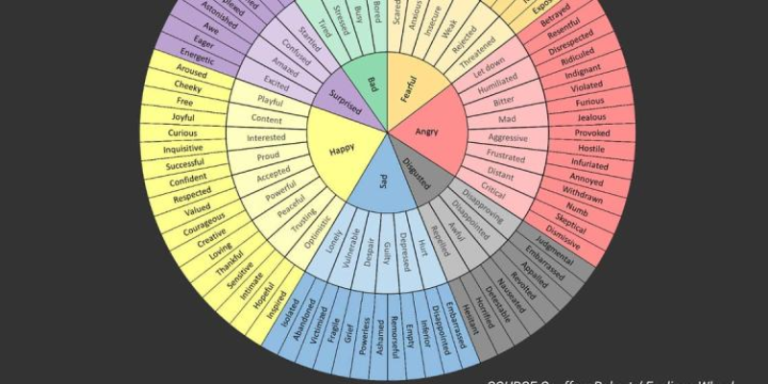Emotions are fundamental to human experience, shaping how we perceive and interact with the world around us. Despite their significance, many people struggle to identify and articulate their emotions accurately, leading to misunderstandings, conflicts, and even mental health challenges. Identifying emotions, as illustrated by tools like the “Feel Wheel,” is a powerful strategy for enhancing emotional intelligence and promoting psychological well-being.
The Science Behind Identifying Emotions
Psychologists and neuroscientists have long studied the impact of identifying emotions on mental health. According to Lisa Feldman Barrett, a renowned psychologist and author of How Emotions Are Made, emotions are not universally experienced but are constructed by our brains based on past experiences and the social context in which we live (Barrett, 2017). This constructivist view implies that the more accurately we can label our emotions, the more control we have over them. Identifying an emotion reduces its intensity by engaging the brain’s prefrontal cortex, responsible for rational thought and decision-making. This process, known as “affect labeling,” allows individuals to regulate their emotional responses effectively (Lieberman et al., 2007).
The Role of Emotional Granularity
The concept of emotional granularity refers to the ability to differentiate between and accurately label a wide range of emotions. People with high emotional granularity can identify subtle differences between feelings like frustration and annoyance or joy and satisfaction. This skill is associated with numerous psychological benefits, including better coping strategies, improved relationships, and enhanced mental health (Kashdan et al., 2015).
For instance, a person who can distinguish between feeling “disappointed” and “betrayed” may be better equipped to address the underlying issues causing these emotions. Disappointment might lead to a reassessment of expectations, while betrayal might prompt a conversation about trust. By Identifying these emotions accurately, individuals can take appropriate actions to resolve the situations causing their distress.
The “Feel Wheel” as a Practical Tool
The “Feel Wheel,” as shown in the image, is a practical tool that helps individuals articulate their emotions by providing a visual representation of various feelings. It categorises emotions into broad categories like “Happy,” “Sad,” “Angry,” “Fear,” “Calm,” and “Strong,” each further divided into more specific emotions. This hierarchical structure encourages users to delve deeper into their emotional states, promoting greater self-awareness and emotional intelligence.
Emotional intelligence, a concept popularised by Daniel Goleman in his book Emotional Intelligence: Why It Can Matter More Than IQ, is crucial for personal and professional success. Goleman argues that individuals who can manage their emotions and understand the emotions of others are more likely to succeed in life (Goleman, 1995). The “Feel Wheel” can be an essential tool in developing this form of intelligence, as it provides a concrete method for practising emotional granularity.
Practical Applications and Benefits
Incorporating the practice of Identifying emotions into daily life can have profound benefits. For example, in therapeutic settings, clients who accurately name their emotions are more likely to achieve positive outcomes in treatment. Cognitive-behavioural therapy (CBT), a widely used therapeutic approach, often involves identifying and challenging negative thoughts associated with emotions. By Identifying emotions, clients can better understand the triggers for their negative thought patterns and work with their therapists to develop healthier coping mechanisms (Beck, 2011).
Moreover, in educational settings, teaching children to name their emotions can lead to improved emotional regulation and social interactions. According to research published in The Journal of Educational Psychology, children who are taught to label their emotions are better equipped to manage stress and exhibit higher levels of empathy towards their peers (Rivers et al., 2012).
Identifying emotions is a powerful tool that can significantly enhance emotional intelligence and well-being. By using resources like the “Feel Wheel,” individuals can develop a deeper understanding of their emotional states, leading to more effective communication, better decision-making, and improved mental health. As we continue to explore the complexities of human emotions, the simple act of Identifying our feelings may prove to be one of the most effective strategies for achieving emotional balance and resilience.
References:
Barrett, L. F. (2017) How Emotions Are Made: The Secret Life of the Brain. Houghton Mifflin Harcourt.
Beck, A. T. (2011) Cognitive Behavior Therapy: Basics and Beyond. Guilford Press.
Goleman, D. (1995) Emotional Intelligence: Why It Can Matter More Than IQ. Bantam Books.
Kashdan, T. B., Barrett, L. F., & McKnight, P. E. (2015). “Unpacking Emotion Differentiation: Transforming Unpleasant Experience by Perceiving Distinctions in Negativity”. Current Directions in Psychological Science. 24(1), pp. 10-16.
Lieberman, M. D., Inagaki, T. K., Tabibnia, G., & Crockett, M. J. (2007) “Subjective Responses to Emotional Stimuli During Labeling, Reappraisal, and Distraction”. Emotion. 7(3), pp. 468-480.
Rivers, S. E., Brackett, M. A., Katulak, N. A., & Salovey, P. (2012) “Regulating Emotion in the Classroom: The Effectiveness of the RULER Approach”. The Journal of Educational Psychology. 104(3), pp. 649-657.









